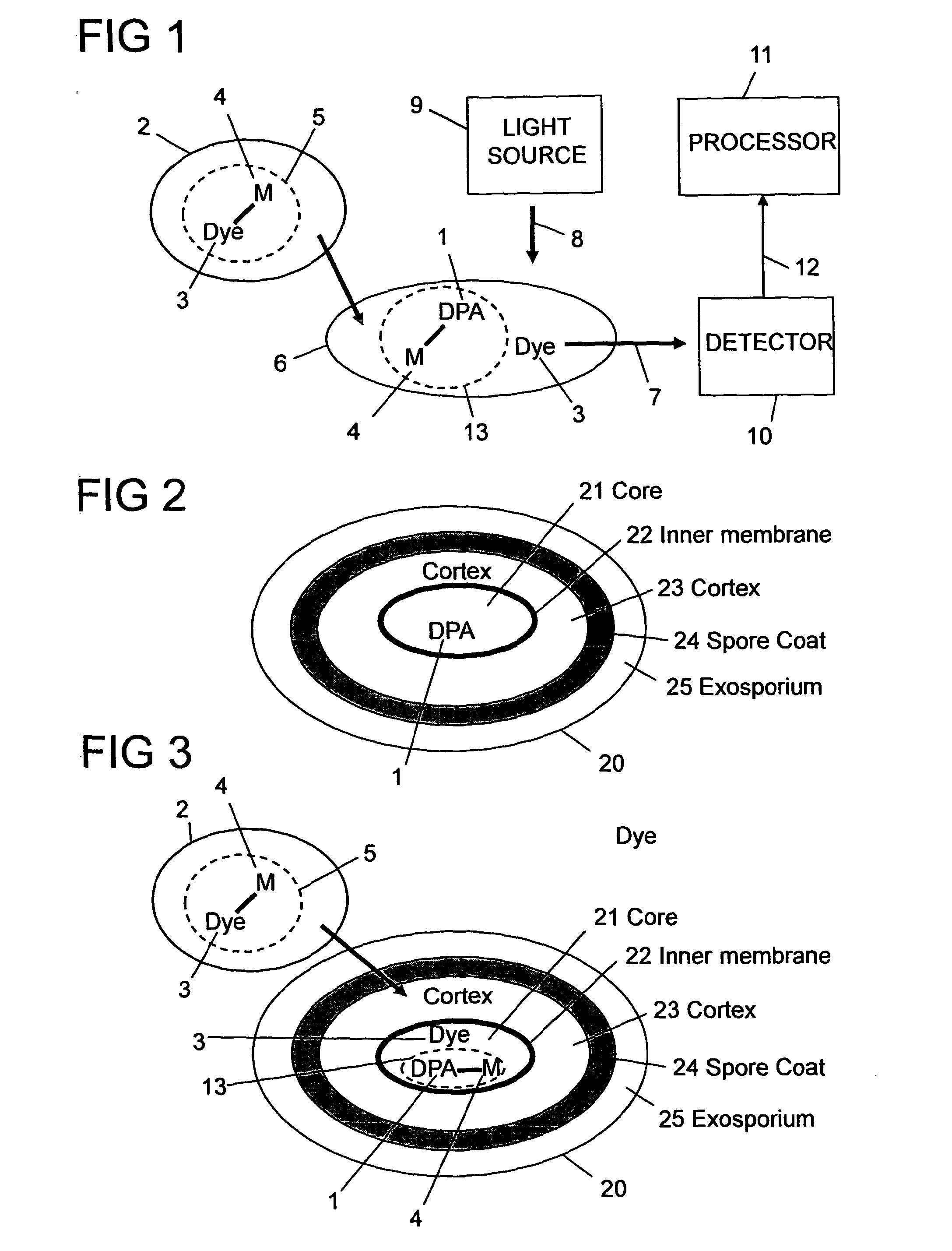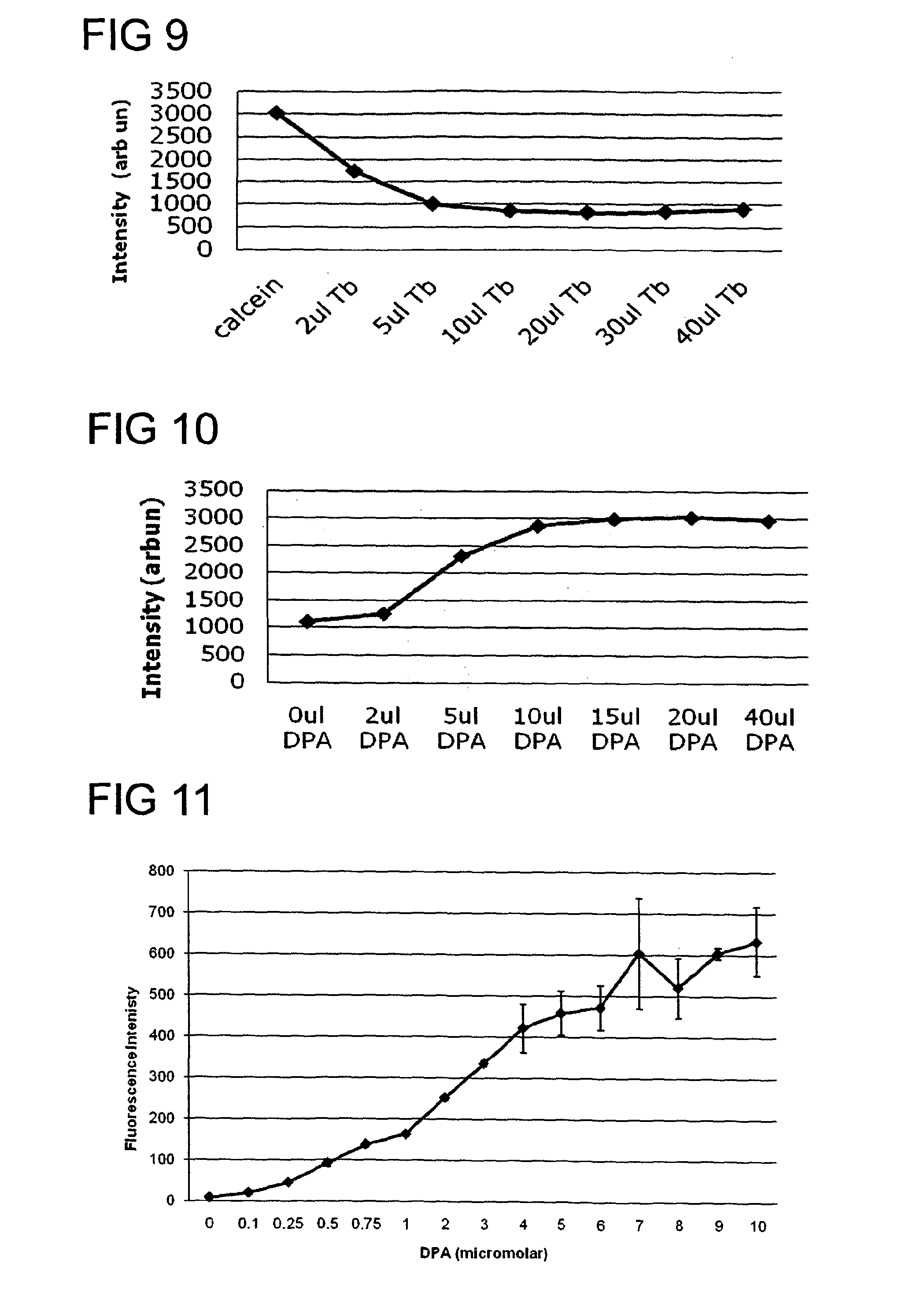Method, reagent, and apparatus for detecting a chemical chelator
a chemical chelator and reagent technology, applied in biochemistry apparatus and processes, material analysis through optical means, instruments, etc., can solve the problems of insufficient cost-effectiveness, inability to monitor risk, and inability to use regularly outside the laboratory. , conventional laboratory based techniques requiring culturing of microorganisms are accurate, and are not suitable for general use to monitor hygien
- Summary
- Abstract
- Description
- Claims
- Application Information
AI Technical Summary
Benefits of technology
Problems solved by technology
Method used
Image
Examples
example 1
[0159]Several fluorescence dyes, including fluorescein, rhodamine and calcein, were screened for their ability to bind to zinc, cobalt, terbium, aluminium, and several other metal ions. Their fluorescence emission was recorded before and after adding the metal ion. Many of these show quenching of the fluorescence. One of the efficient dyes was calcein whose fluorescence was quenched by a number of different metal ions including ions of zinc, cobalt, iron and terbium. These ions were tested for their ability to bind to DPA. The binding ability to DPA is variable in terms of affinity. Preferably the metal ion and the dye are selected such that the DPA has a higher affinity to bind to the metal ion than the dye binding to the metal ion for sensitive detection. From this study, terbium and europium were found to be two of the most efficient metal ions in terms of their quenching effect on calcein and ease of dequenching with DPA. although many others were also shown to have potential. S...
example 2
[0160]Calcein and terbium (III) chloride hexahydrate, europium (III) chloride hexahydrate, cobalt (II) chloride hexahydrate, lead (II) chloride, calcium chloride and other general chemicals and solvents were purchased from Sigma-Aldrich (UK).
[0161]Calcein was selected as the luminescent dye 3, and terbium as the metal ion 4. The fluorescence emission signal 7 was recorded using an excitation wavelength (λex) 82 of calcein set at 485 nm and the emission wavelength (λem) 83 set at 520 nm. FIG. 9 shows the quenching of the fluorescent signal when a fixed concentration of calcein (1.2 μM) is titrated with various aliquots (μL) of terbium chloride (2 mM) solution. As more and more terbium chloride is added, the fluorescence signal drops. From this quenching curve a ratio of greater than four terbium ions per calcein molecule was found to quench the fluorescent signal efficiently. Therefore from such information, quenched solutions of calcein and terbium mixture could be prepared for test...
example 3
[0162]A dilute solution comprising calcein and terbium chloride in 1:8 molar ratio, respectively, was prepared in 10 mM TES buffer pH 7.4. Various amounts of DPA were titrated into this solution and changes in fluorescence intensity of calcein measured using an excitation wavelength of 485 nm and emission at 520 nm. FIG. 11 shows the dose response curve for DPA detection.
[0163]Further optimization of this assay and reagents including molar ratio and nature of dye and metal used may produce dose response curves with even higher sensitivity.
[0164]It is also possible to use the invention to detect chelators other than DPA. Different chelators may respond differently depending on their binding affinities to the metal. To illustrate how a suitable chelator may be identified the fluorescence emission spectrum of the calcein-terbium stain was recorded in the presence and absence of DPA, EDTA, Lactic acid, 2,6-Diaminopimelic acid (DAP), N-Acetylmuramic acid and acetic acid.
[0165]FIG. 31 sho...
PUM
| Property | Measurement | Unit |
|---|---|---|
| molar concentration | aaaaa | aaaaa |
| volume | aaaaa | aaaaa |
| excitation wavelength | aaaaa | aaaaa |
Abstract
Description
Claims
Application Information
 Login to View More
Login to View More - R&D
- Intellectual Property
- Life Sciences
- Materials
- Tech Scout
- Unparalleled Data Quality
- Higher Quality Content
- 60% Fewer Hallucinations
Browse by: Latest US Patents, China's latest patents, Technical Efficacy Thesaurus, Application Domain, Technology Topic, Popular Technical Reports.
© 2025 PatSnap. All rights reserved.Legal|Privacy policy|Modern Slavery Act Transparency Statement|Sitemap|About US| Contact US: help@patsnap.com



